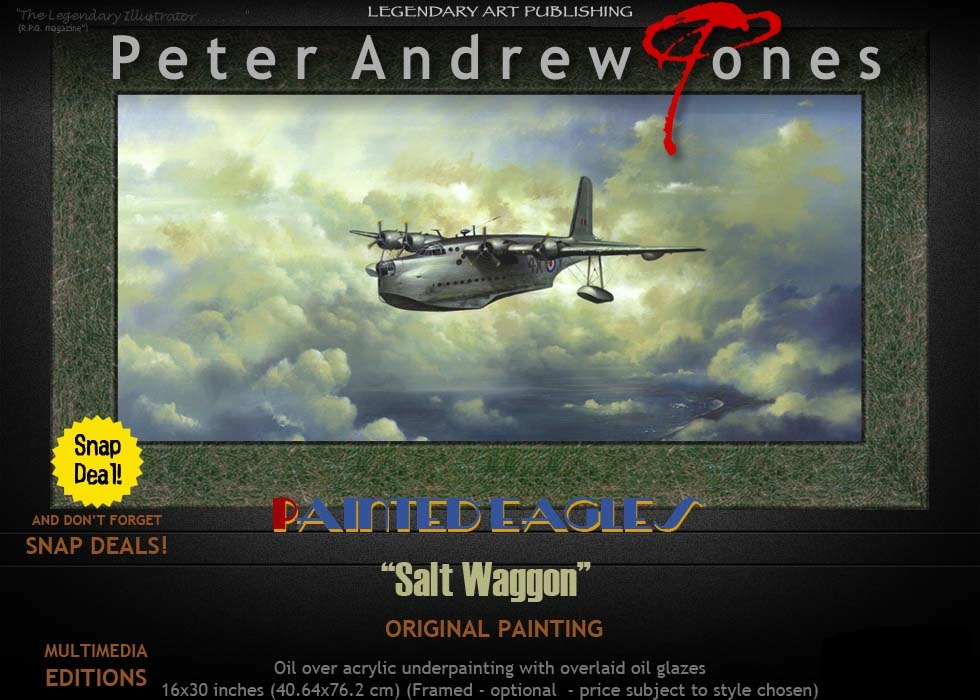 "SALT WAGGON" "SALT WAGGON"
 Short Sunderland Flying Boat Short Sunderland Flying Boat
 By : Deborah Susan Jones : Editor & contributing
writer. By : Deborah Susan Jones : Editor & contributing
writer.
 "Nicknamed
"The Flying Porcupine" ("Fliegende Stachelsweine") by the Luftwaffe
because it was heavily armed and able to amply defend itself if
attacked, it saw further unexpected but gallant service in 1948, at the
dawn of the Cold War, when the Soviet Union sealed off all Allied land
access to then occupied Berlin, leaving air as the only means of
supplying the Allied-occupied sectors of the city. "Nicknamed
"The Flying Porcupine" ("Fliegende Stachelsweine") by the Luftwaffe
because it was heavily armed and able to amply defend itself if
attacked, it saw further unexpected but gallant service in 1948, at the
dawn of the Cold War, when the Soviet Union sealed off all Allied land
access to then occupied Berlin, leaving air as the only means of
supplying the Allied-occupied sectors of the city.
 During
the Berlin Airlift (Codenamed Operation Plain Fare - 24th June
1948 - 30th September 1949) some of the resupply effort was
carried out by British RAF Sunderland flying boats, using Lake Wannsee
near Berlin for landing and taking off, to supply two million West
Berliners with food, fuel and other supplies which, at its peak, saw
one plane reach West Berlin every 30 seconds. During
the Berlin Airlift (Codenamed Operation Plain Fare - 24th June
1948 - 30th September 1949) some of the resupply effort was
carried out by British RAF Sunderland flying boats, using Lake Wannsee
near Berlin for landing and taking off, to supply two million West
Berliners with food, fuel and other supplies which, at its peak, saw
one plane reach West Berlin every 30 seconds.
 On 5th
July the effort was augmented by ten Short Sunderland flying boats
from No.201 (Sunderland GR V) and No.230 (Sunderland GR V)
squadrons which flew a shuttle service from a temporary base
at Finkenwerder on the Elbe near Hamburg, and were used to
transport goods to the city, landing on the Havelsee lake beside RAF
Gatow (until it iced over). On 5th
July the effort was augmented by ten Short Sunderland flying boats
from No.201 (Sunderland GR V) and No.230 (Sunderland GR V)
squadrons which flew a shuttle service from a temporary base
at Finkenwerder on the Elbe near Hamburg, and were used to
transport goods to the city, landing on the Havelsee lake beside RAF
Gatow (until it iced over).
 Each
aircraft carried 4 1/2 tons into the city and flew out manufactured
goods and starving refugees on each trip. They flew more than 1,000
sorties until ice-flows on the Havelsee stopped flights on 15th
December. Being flying boats the Sunderlands could withstand salt
corrosion so were ideally tasked to carry urgently needed salt
supplies, which other aircraft could not carry due to the risk of
corrosion leading to airframe failure, which could occur quite quickly. Each
aircraft carried 4 1/2 tons into the city and flew out manufactured
goods and starving refugees on each trip. They flew more than 1,000
sorties until ice-flows on the Havelsee stopped flights on 15th
December. Being flying boats the Sunderlands could withstand salt
corrosion so were ideally tasked to carry urgently needed salt
supplies, which other aircraft could not carry due to the risk of
corrosion leading to airframe failure, which could occur quite quickly.
 Deborah Susan Jones : Editor Deborah Susan Jones : Editor
|



![]() Deborah Susan Jones : Editor
Deborah Susan Jones : Editor 










